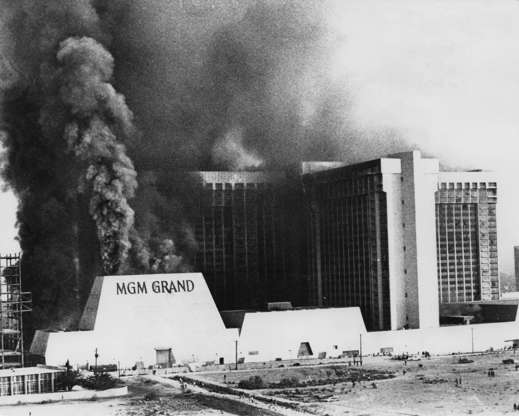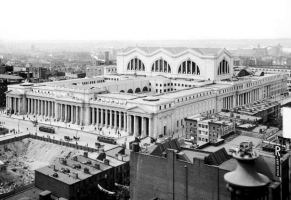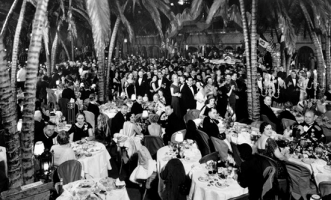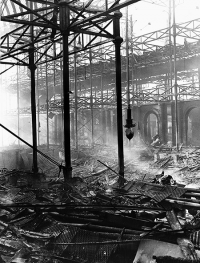New York, NY Wall Collapses Into Tenement Building, Dec 05 1946
46 TRAPPED IN TENEMENT FIRE
8 KNOWN DEAD; 38 BURIED UNDER TONS OF DEBRIS.
CRUMBLING WALL CRASHES INTO BUILDING.
New York (AP) -- At least eight persons were dead and 38 others, including children, were believed buried under tons of debris following a five-alarm fire early today in an abandoned icehouse on Manhattan's upper West Side, which caused a five-story wall to collapse, crumpling an adjoining tenement building.
Police and firemen, digging frantically against time, removed four bodies from the wreckage and said they had sighted four more. Nearby hospitals admitted more than a score of injured. Ambulances were rushed to the scene and a first aid station was set up.
The identified dead are FRANK MOOREHEAD, 27-year-old, fireman; ANTHONY BLANCARDI, 11; DANIEL CORRADO, 25; and THOMAS PHILLIPS, 70. All except the fireman were residents of the tenement building.
THOMAS P. BROPHY, fire marshal, said the cause of the fire was not known. A small rubbish fire had been extinguished the day before in the ice plant, located at 484 W. 184th st.
Six children between the ages of four and 12 years old, who had played in the icehouse Wednesday, were questioned by police in an effort to learn whether they might have started the fire.
The noise of the toppling walls caused first reports to list the disaster as an explosion.
The pile of debris from the tenement building was as high as the second story. One portion of the tenement was flattened the other wrecked by the force of the collapse, which virtually sheared the building in half.
Blood plasma units were available at the scene. Priests from a nearby parish clambered over the debris to administer last rites as two derricks bit into the wreckage.
Police pulled from the wreckage JOSEPH POPER, JR.,nine years old. He had cried and shouted until help reached him. He said his brother and sister still were trapped.
NICK SLOAN, 29, also was pulled out alive. He guided rescuers by shouting and throwing stones and rubble. His wife, brother and two little daughters still are missing.
Emergency crews tearing at the wreckage with bars, picks and bare hands came across the pitiful remnants of gaily wrapped Christmas packages, holly and bits of tinsel.
One priest, the REV. DAVID REN, climbed a ladder to reach a broken body and gave last rites. He also saw the legs and feet of two others protruding from the wreckage.
Mayor WILLIAM O'DWYER rushed to the scene and promised an investigation. Crowds watched rescue efforts from nearby rooftops and police roped off nearby streets.
Among those listed as missing were a mother, MRS. EDITH DIRICA, 31 and three children, CHARLES, 12, MARGARET 5, and MARY, six months.
The collapse came 15 minutes after the fire broke out at 12:10 A. M. CHARLES WHITECROFF, nearby resident, said the cavein "felt like an earthquake" and was followed by "terrible screaming of children."
After the collapse, firemen heard frantic cries from the ruins and were able to drag out a number of victims.
DR. HARRY M. ARCHER, Fire Department surgeon, said he had crawled into the rubble and had given a hypodermic injection to a woman who clutched the dead body of a young boy.
The REV. JOSEPH A. BOYLE, Fire Department chaplain, also went into the ruins. He said he heard a woman calling weakly, "Please get me out of here. I'm all right." Firemen worked toward her.
Many of the more than 200 firemen at the scene formed a human chain, passing bricks, wood, masonry and smashed furniture to the street so rescue crews could dig deeper.
One crew of firemen tunneled with their hands through six feet of wreckage to reach a young girl, still alive. She was given a hypodermic injection. A fireman wept with relief as he carried to safety a small boy who was still able to smile, though injured.
Syracuse Herald-Journal New York 1946-12-12
---------------------------------
ABANDON HOPE FOR 15 BURIED
STEAM SHOVELS CLEAN DEBRIS.
New York (AP) -- Weary workers who dug the bodies of 21 persons from the wreckage of a collapsed, tenement house in a slow, grim procession of death gave up hope today for the lives of 15 others believed buried under tons of rubble.
As the broken body of ROSE FUCCI, 15, was extricated from the ruins, police said they planned to set three steam shovels to work on the ruins of the building in which more than 30 were injured. Workers had previously carefully dug by hand because they feared heavy machinery would cause more crashes.
The building at 2515 Amsterdam ave. in upper Manhattan, which housed 22 families, was smashed early thursday by a two-foot thick wall of an adjoining ice house which toppled on it after a five-alarm fire in the ice house.
Rescue workers toiled all night in the glare of huge searchlights which played over the six-story structure's gaunt remains.
Continued on
http://www.gendisasters.com/new-yor...ollapses-tenement-building,-dec-1946?page=0,1





